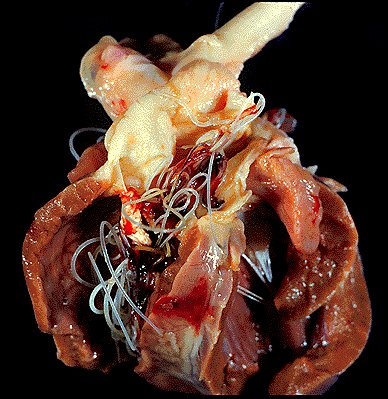
Canine Heartworm Disease

All dogs are at risk of developing heartworm disease, regardless of whether or not they spend most of their day indoors.
Once a dog has contracted this serious disease, treatment can be complicated, risky and expensive. Without treatment, however, the disease is often fatal. Therefore, heartworm prevention is the best way to protect your dog.
Heartworms are large worms which live in the large blood vessels surrounding the heart.
They reproduce to generate microscopic microfilariae which live in the blood stream and later develop inside mosquitos which feed off the dog. When the mosquito bite another dog, the microfilariae are transmitted and the disease is spread.
Clinical Signs
Adult heartworms obstruct the major blood vessels of a dog's lungs. The severity of clinical signs is highly dependent on the number and size of the worms. The most common symptom of heartworm include a dry cough, shortness of breath, loss of appetite, weight loss, weakness and fatigue. In more serious cases, fluid will accumulate in the belly and may cause a noticeable swelling.
Diagnosis
Heartworm can be identified and diagnosed early by your veterinarian with a simple blood test, examining the blood for the presence of microfilariae. Another type of blood test may also be performed to rule out the possibility of an infection with worms in the absence of microfilariae. Your veterinarian may also suspect heartworm disease if your pet has evidence of cardiovascular disease or an enlarged heart on x-rays.
Treatment

All dogs are at risk of developing heartworm disease, regardless of whether or not they spend most of their day indoors.
Once a dog has contracted this serious disease, treatment can be complicated, risky and expensive. Without treatment, however, the disease is often fatal. Therefore, heartworm prevention is the best way to protect your dog.
Heartworms are large worms which live in the large blood vessels surrounding the heart.
They reproduce to generate microscopic microfilariae which live in the blood stream and later develop inside mosquitos which feed off the dog. When the mosquito bite another dog, the microfilariae are transmitted and the disease is spread.
The only way to detect heartworm disease in its early states in through a blood test. A veterinarian, using relatively simple diagnostic procedures, can usually detect the tiny heartworm microfilariae in an infected dog's blood.
occasionally, an infected dog will have adult heartworms but no microfilariae. In such cases an x-ray or echocardiogram as well as other laboratory tests may be needed to confirm heartworm infection.
- All About German Shepherd Puppies
- Pet Disease and Allergies
- Hips and Elbows
- German Shepherd Dog Anatomy
- What is Schutzhund
- German Shepherd Behavior
- Quick Tips On German Shepherds
- Our Show Dogs










